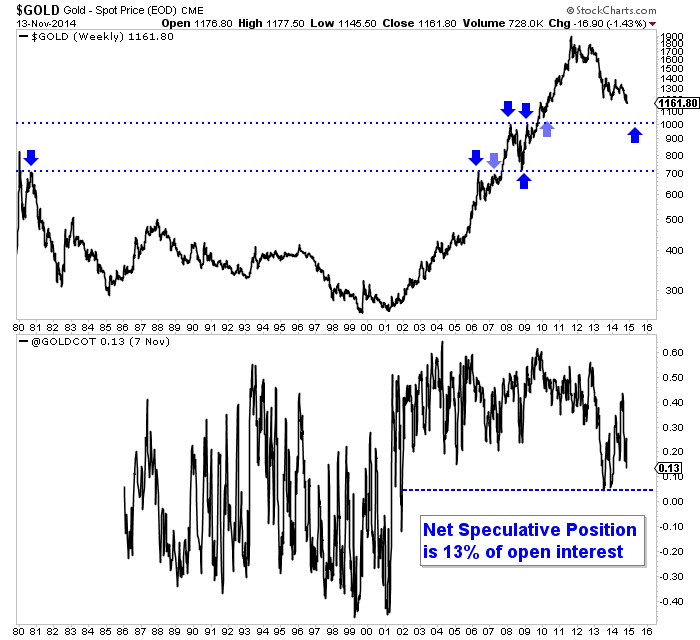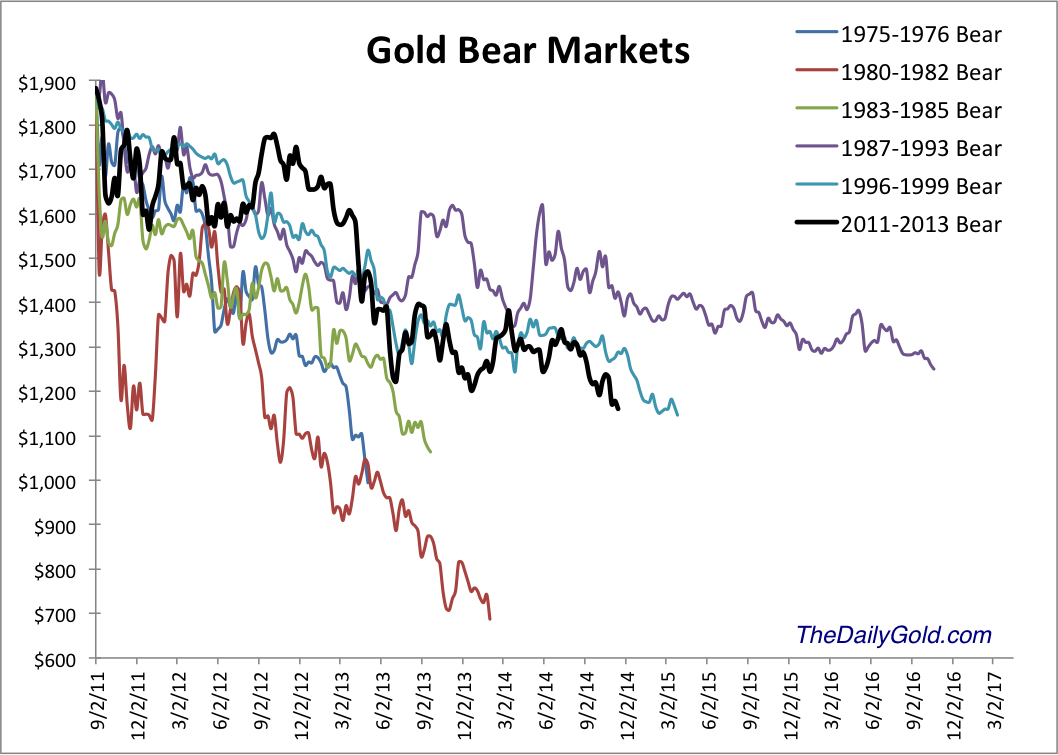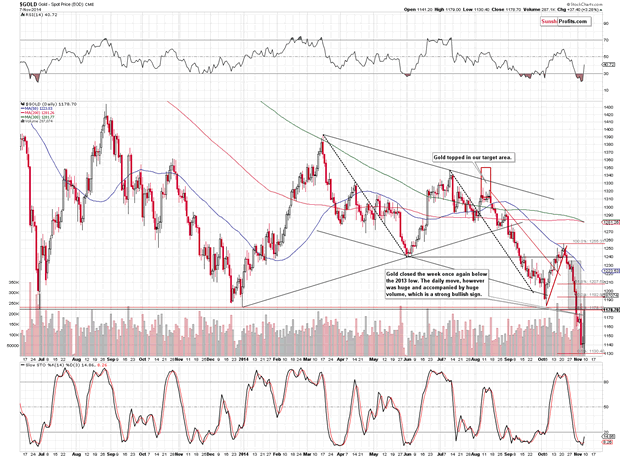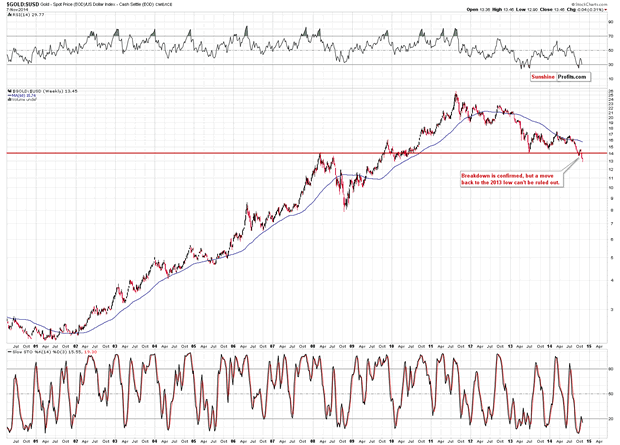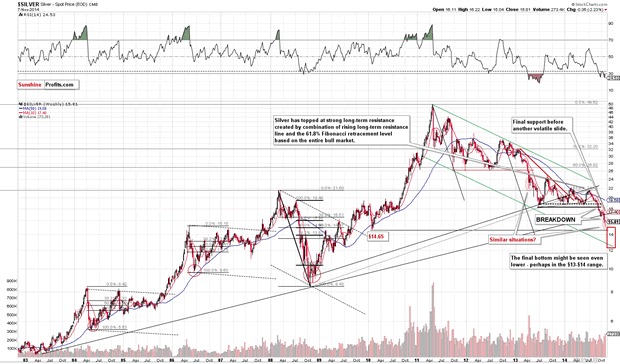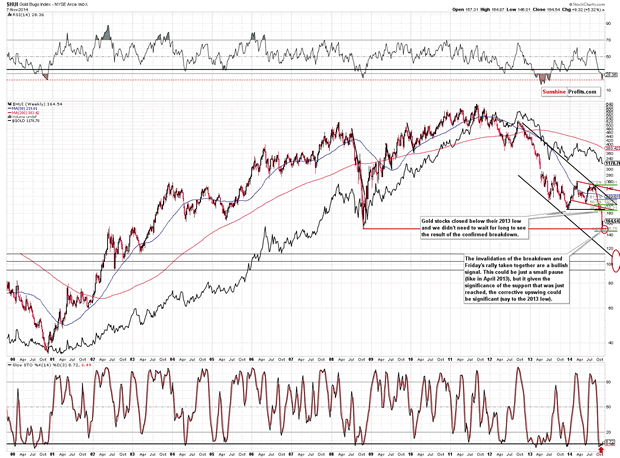Gold & Precious Metals
Gold Bulls Have The Trend Line Edge
Posted by Morris Hubbartt - Super Force Signals
on Friday, 14 November 2014 17:43

Today’s Videos:
Gold Bulls Have The Trend Line Edge Charts Analysis
Silver Trend Line Target Charts Analysis
Dow Waning Rally & US Dollar Blow-Off Top Charts Analysis
GDX Rally To The Trend Line Charts Analysis
GDXJ Triple Gap Play Charts Analysis
Franco Nevada Swing Trade Charts Analysis
Thanks,
Morris
Unique Introduction For Web Readers: Send me an email toalerts@superforcesignals.com and I’ll send you 3 of my next Super Force Surge Signals free of charge, as I send them to paid subscribers. Thank you!
The Super Force Proprietary SURGE index SIGNALS:
25 Super Force Buy or 25 Super Force Sell: Solid Power.
50 Super Force Buy or 50 Super Force Sell: Stronger Power.
75 Super Force Buy or 75 Super Force Sell: Maximum Power.
100 Super Force Buy or 100 Super Force
Sell: “Over the Top” Power.
Stay alert for our Super Force alerts, sent by email to subscribers, for both the daily charts on Super Force Signals at www.superforcesignals.com and for the 60 minute charts at www.superforce60.com
About Super Force Signals:
Our Super Force signals are created thru our proprietary blend of the highest quality technical analysis and many years of successful business building. We are two business owners with excellent synergy. We understand risk and reward. Our subscribers are generally successful business owners, people like yourself with speculative funds, looking for serious management of your risk and reward in the market.
Frank Johnson: Executive Editor, Macro Risk Manager.
Morris Hubbartt: Chief Market Analyst, Trading Risk Specialist.
Email:
Mail:
SFS Web Services
1170 Bay Street, Suite #143
Toronto, Ontario, M5S 2B4
Canada

Gold’s Support at $1000/oz.
Posted by Jordan Roy-Byrne - The Daily Gold
on Friday, 14 November 2014 13:09
“As winter beckons we could be looking at a lifetime buying opportunity”
Gold and gold miners have rebounded but remain in a technically weak position. Both markets have failed to move beyond the highs made last Friday. The same happened to the gold stocks in early October. They exploded higher one day but failed to muster anything after that. At that time Gold continued its rally for a few weeks. This time Gold has struggled to sustain Friday’s gains. While we are coming to the end of the bear market and one should not be too bearish, the downside target of $1000/oz Gold remains well in play.
The chart below shows the weekly Gold close since 1980 and the net non-commercial (speculative) position as a percentage of open interest. From this chart we can deduce the two most important levels: $720/oz and $1000/oz. Give or take $5/oz, $720/oz was the secondary peak in 1980, the peak in 2006, small resistance in 2007 and major support in 2008. Gold’s bottom in 2008 wasn’t random. It bottomed at an important pivot point around $700/oz. Today, Gold is in a downtrend without any major support until the $1000/oz level. That level marked important support and resistance from 2008 to 2010 and is the next major support.
As a percentage of open interest, the net speculative position is 13%. It’s low of 5% in 2013 marked an 11-
year low. If Gold declines near $1000/oz, I’d bet the net speculative position would fall below 5% and reach a 13-year low. That qualifies as extreme bearish sentiment. The physically backed ETFs CEF and GTU are already showing sentiment at major multi-year extremes.
The $1000/oz target expressed above also fits very well with history as we’ve shown numerous times in this bear analog chart.
While the downside for Gold and Silver may be limited (in percentage terms), the downside for miners could be quite a bit more. With Gold trading at $1160/oz, it would have to fall about 13% to reach $1000/oz. That is not so bad if you hold Gold. However, a 13% fall in Gold could cause a 20% fall in the miners or more. If a gold producer has a $200 profit margin at $1200/oz then he does not have much profit at $1050 Gold. If a junior has a deposit that can earn good money at $1300/oz then that isn’t worth much if Gold drops to $1050. Thus, a fair amount of downside potential remains in play. On the other hand, it works in your favor if you buy very low and Gold recovers.
In any event the bear market is very close to its end. The weeks and months ahead figure to be enticing and exciting for precious metals traders and investors. Expect quite a bit of day to day volatility as we see forced liquidation and occasional short covering. Opportunities are fast approaching so pay attention. Be patient but be disciplined. As winter beckons we could be looking at a lifetime buying opportunity.
Good Luck!
Jordan Roy-Byrne, CMT
Our premium service includes a report on our top 5 stocks to buy at the coming bottom.

Faber: Gold, Swiss Gold Referendum, China, US Dollar
Posted by Marc Faber - Bloomberg Interview Transcript
on Thursday, 13 November 2014 21:42
 – How will the Swiss gold referendum affect the gold market?
– How will the Swiss gold referendum affect the gold market?
– China and gold reserves: How much gold does China have?
– Is the US dollar in a new major bull market?
– Is it possible for gold to go under $1,000?
– Could Russia and other emerging market central banks sell gold?
video posted Nov 12, 16:58 minutes

During a time in which sentiment towards natural resources is bordering on doom, Rick Rule, Chairman of Sprott U.S. Holdings was kind enough to share a few comments.
Speaking first toward the phenomenon of market capitulation Rick noted that, “Capitulation is a very dramatic event. It’s when most participants in the market give up completely and simultaneously.They are two or three week periods [of] extraordinary [share price] violence. They’re emotionally driven rather than arithmetically driven events.”
One of the more important utilities of a capitulation according to Rick, is that, “In my experience they have marked definitively the end of long bear markets.”
When asked for a prediction on the gold price, Rick concluded that, “[The fight] is between gold and the U.S. 10 yr. treasury—and I don’t see how over 5 years we can possibly lose that fight.”
Here are his full interview comments with Sprott Global Resource Investment’s Tekoa Da Silva. To listen to the interview with Rick Rule (MP3 Download). Transcript below:
Tekoa Da Silva: Rick, we’ve had an ongoing conversation over the last year on “issuer capitulation.” For the person reading, can you explain that concept, and what’s the climate of that conversation in the resource market right now?
Rick Rule: Capitulation is a very dramatic event. It’s when most participants in the market give up completely and simultaneously. I’ve been through three of them before. They are two or three week periods with very violent volatility, but mostly on the downside. It’s a situation where the few remaining buyers which have carried up a market give up, and the sellers begin to bail out at all costs.
Things that contribute to capitulations (because they’re irrational activities) could be things like the simple fact that the calendar month of October has witnessed so many down cycles before. The apparent end of quantitative easing might also scare people, and the idea that they need to get out before pending tax-loss sales.
What marks capitulations are their extraordinary violence, their relatively short duration, and the fact that they’re emotionally driven rather than arithmetically driven events. What’s useful about capitulations, is that in my experience they have marked definitively the end of long bear markets.
Markets turn from bad to good as a consequence of markets outperforming expectations, and capitulation dooms expectation. At the end of a capitulation period, the only outlook for the market is bad, and as a consequence (and by definition) it’s almost impossible for the market not to outperform. That’s been the case of every prior capitulation I’ve experienced.
The other utility of a capitulation is that it becomes broad-based. It extends not only to speculators, but also to officers and directors of junior mining companies. If we are going into an issuer capitulation period now, if past is prologue what will happen is that the issuers will finally lose hope for raising money in a higher market. They’ll go ahead and raise the money they need now, and they’ll begin the process of exploring their properties. You cannot save your way to prosperity in this business, you can only make money by investing money in exploration and development.
For 18 months the issuers have played chicken with the market, waiting to raise more money until share prices theoretically go higher, and as a consequence generated no value that would cause the share prices to go higher. The hallmark of the 2000 capitulation as an example, was to bring the very best issuers (the Robert Friedlands, Ross Beatys, Bob Quartermains and Lukas Lundins) back to market to say, “Let’s go, let’s raise money, let’s build.”
TD: What is the most common objection you receive when approaching these issuers with respect to capital needs, and is there a cycle of objections you see them going through?
RR: As an institution, we at Sprott have probably approached three dozen junior explorers or developers in the last 12 months and said, “We think it’s time for you to advance your project more aggressively. We have faith in you, we like your property.” In response the issuers have said uniformly, “Thank you for your faith, but we can’t raise money at this price. This price is too cheap. At this price we dilute our existing shareholders too much.”
While we think that’s admirable in one regard, the issuers need to remember that this is a capital intensive business, and if you have no capital you have no business because you have no income.
What happens as a consequence of not raising money, is that the only money they spend is on general and administrative expenses, which in effect means that they cannibalize their business and generate their own dilution.
TD: Rick, we had a meeting at our offices here recently, and you said something very interesting. It had to do with mainstream news stories in the financial media and their irrelevance toward our specific investments. You indicated that relevant items to our investments are things such as cash flow and discounted net present value of an asset.
Can you speak to that concept?
RR: Tekoa, I think you would agree that most news on the major media isn’t really issue-oriented. It’s become entertainment. When the nightly news in San Diego focuses on a cat stuck up a tree (a human interest story), as opposed to stories that are real with regard to San Diego, it tells you something about the utility of watching the nightly news.
That extends, of course, to the financial news. People are interested in the big picture, but people make money on their investments at the firm level. People make money in investing by understanding events that are intrinsic to the company they intend to invest in. Additionally, your expectation of the future colors the way you value investments. As an example, if you were of an opinion that the gold price was going to rise, you might be more generous with regards to valuing a company’s resources and reserves than would otherwise be the case.
What happens to people who focus too slavishly on the news, is that they disarm themselves. They take themselves away from examining fundamentals such as the cash needs and the cash generating capabilities of a company, and focus more on cats stuck in trees.
TD: Rick, what would you say is the biggest advantage available in today’s metals and mining market, and what would you say is the biggest risk?
RR: Tekoa, we at Sprott have emphasized to our clients for 20 years the need to understand that natural resource based businesses are extraordinarily cyclical and volatile. The most important thing you could understand in today’s context, is that you have to be a contrarian or you will be a victim. The emotions you’re feeling with regards to your investments are shared by all of your competitors, and right now they are negative—which is to say that your competitors are not showing up to make investments in “out of favor” sectors.
The way you make money is by buying low and selling high. Selling high presupposes that you buy low. When is it most possible to buy low? When all of your competitors are scared to death, which is a different way of saying “right now.”
Can it go lower? Of course it can go lower. But what’s the probability that the downside materially outweighs the upside? Nil, in my opinion.
Conversely, what’s the biggest risk? Easy. For every investor the biggest risk is not Obama, not the central banks, not the big thinkers of the world, and it’s not even Congress. The biggest risk to each individual investor is conveniently located to the left of the right ear, and the right of the left ear. Almost everybody’s worst wounds are self-inflicted. Allowing your emotion and your experience in the immediate past to overly influence your expectation of the future will cause you to dismiss arithmatic and replace it with prejudice, which is where most people conspire to lose the most money.
TD: Rick, you’ve taught me a lot about the cyclical nature of the resource business, so I’d like to ask—what gives you the confidence we will have another upcycle in natural resources, and how far back does your experience go in terms of cycle participation?
RR: Well, my own experience goes back to the early 1970s, so sadly, that experience is long indeed. Confidence in resource markets can be as broad as confidence in the ascent of man—the longest running bull market in history. Despite the ups and downs, society over time increases its standard of material well-being, and simultaneously, increases its size. We’re at 7 billion and counting, there’s more people being born every day, and they all want to eat, Tekoa. That’s the broadest set of circumstances we’re in.
It’s odd to me that resource investors, perhaps because of the hard money origins of many of them, believe a catastrophic decline will be the best possible outcome for the resource business. That’s wrong. The best possible outcome for the resource business would be a boom, which increases utilization of commodities, and secondly, increases savings in gold which is an important part of the savings matrix of many people on earth.
Hence, the more wealth that’s generated, the more demand we’ll see for gold as part of the savings matrix. I believe the set of circumstances that’s in front of us is severe but survivable. I lived through the down cycle in the 1970s and it was certainly dramatic; interest rates in the double digits, civil insurrection, generational change in the United States, as well as the Vietnam War.
The situation we have in front of us is certainly no better than that, but probably no worse either. The outcome is that the laws of supply and demand, and the laws of the market will ultimately prevail over the headlines.
The truth is that the material goods humans require will always do well. People will always need to eat, and they’ll always want access to electricity which requires coal, nuclear, and copper. As people (particularly people in frontier and emerging markets) acquire more wealth, they’ll require more savings products.
Again, an important part of the savings matrix in places like China, South Asia, India, and Pakistan, is gold. So ironically, an increase in living standards would probably be better for gold investors than a decrease in living standards. While I expect the time ahead of us will be turbulent, I also suspect that resource investors will do very well—in particular Tekoa, because we’re starting from such a low base.
Think about the TSXV for a moment, an index down by about 80% in nominal terms, and I say nominal terms because the TSX throws out the worst companies. They throw out the people who failed. In real terms, that’s a market that’s down by 85%, which is arithmetically (and simultaneously) 85% less risky and 85% more attractive.
TD: On the subject of gold, we had the chance to visit a conference recently, the New Orleans Investment Conference. In attendance was former Federal Reserve Chairman Alan Greenspan, who as our readers know, was an early proponent of gold. What was your takeaway in regard to his comments on gold?
RR: Dr. Greenspan was very worth listening to. In the context that his beliefs probably reflect the beliefs of the big thinkers and ruling class in this country, except that he’s probably more philosophically inclined towards you and me, which from my viewpoint makes him particularly interesting. He said as an example, that the beliefs he held in the 1960s as part of Ayn Rand’s inner circle hadn’t changed, but what changed was his job description. He went from being a university professor and a forecaster, to running the Fed, and he had to temper his beliefs in the context of his actions because of the requirements of his job. I found that to be an interesting point.
A second point he made, was that the idea that the Fed “isn’t politicized,” is silly. So while the investing public believes you have this independent Fed, nothing, according to Greenspan, could be further from the truth.
Another point he made that really supports the gold thesis, is that the Fed doesn’t exist to defend the currency. The Fed exists to defend the banking system, which is a very, very different set of circumstances. As we saw in 2008, defending the currency and defending the banking system are often antithetical to each other.
Greenspan further said two things that I think are useful to our audience. When asked about the specific direction of both gold and interest rates, he responded first by saying that he made his living as a forecaster for 35 years, and as a consequence of that, he was very experienced at obfuscation (which I found amusing). The second thing he said when pinned down with regard to the direction of interest rates was—“measurably higher.” In response to the direction of the gold price—“measurably higher.” He said that in the context of his belief – that in a representative democracy wrapped around a welfare state – the demand for goods and services from the state will always exceed the demand for a sound currency.
He further stated the profligacy we experience in the U.S. will not merely continue, but accelerate. He didn’t say it in those exact words, but when he said that a sound currency is incompatible with a representative democracy servicing a welfare state, you begin to understand something about the volatility of change to occur.
TD: Rick, one of the other things I noticed at that conference was the median age of the attendees, which looked to be about 65. What’s the significance of that in your mind? Is it that that age group holds most of the country’s wealth?
RR: I think I have three significant comments to that. First of all, youth is a very good thing, don’t waste it. Secondly, it’s pretty obvious why the audience was so old. The audience that’s attracted to hard money or resource themes, is the audience that came into their investing prime during the decade of the 1970s, when gold ran from $35oz. to $850oz. The audience began to get a little younger in the beginning of the last decade, when the narrative associated with resources became supported by the rise in emerging and frontier markets.
I fully believe two things will happen over the course of the next decade. One, the discussion you and I are having with regard to resources which is not uniformly popular now, will become uniformly popular, as a consequence of the performance of those markets.
Two, as the performance of those markets accelerates, attention being paid by younger observers to that narrative will increase, because people’s expectation of the future is set by their experience in the immediate past. Investors who are less forward thinking than you, Tekoa, but who are of your same age, haven’t explored the topic of natural resources and precious metals, because they’re more caught up in lifestyle topics, they’re more caught up in technology investments, and they’re caught up in narratives that have been more relevant to them.
If the price of copper doubles, or if the price of oil or gold doubles—the importance of this narrative becomes dramatically reinforced by first-hand experience, and the number of people listening to discussions like this will increase and their median age will decrease radically.
TD: Rick, at the few conferences I’ve been to over the last year, I’ve been hit with a question which is relevant to the current or future client of Sprott: what should give them confidence that the next generation at Sprott will be able to carry forward the mandate to manage their assets??
Furthermore, when you walk down the halls at Sprott Global and Sprott Inc. in Toronto, what are the encouraging signs you’re seeing from this next generation?
RR: That’s a wonderful question. The first thing is the culture at Sprott; we are a financial services firm that isn’t overleveraged. We aren’t run like an equity firm that has an 8% equity slice. We have a 100% equity slice, and people who are attracted to Sprott are attracted via the culture, and we don’t think that will change.
The second thing is that young people who are attracted to Sprott and the Sprott culture are instinctively contrarian, or else they’d be going to work at one of the technology underwriters, they wouldn’t be coming to work here. It’s who we are and what we do that attracts these people, which is your first line of assurance that these are hard-working, contrarian people who are willing to invest in their future as opposed to generating capital to consume right this very instant.
The third thing is much more general, and it’s interesting I guess when you hit my age, that the sort of collective wisdom is that the generation or two coming up underneath you is somehow less worthy. I suspect that was the feeling of my generation’s parents and grandparents. But when I visit with people my own age, and they suggest that younger people are less motivated, or less well-educated, I look at them and laugh, and say, “Well you know, you ought to come to work with me—either in Toronto or San Diego.”
When I look at the education, motivation, and maturity of the 30 yr. olds that work at Sprott and compare it to where I was at 30, I’m mightily impressed. The idea that the upcoming generation at Sprott is somehow substandard is laughable. It doesn’t even merit consideration.
TD: As a final question Rick—what’s your prediction on gold prices over the next 3-5 years?
RR: Higher. I have to echo Greenspan in that regard, but I’m not really in the predictions business, I’m in the net present value business. I sleep better owning gold than not, but to answer your question, from my point of view we’re simply locked in a war with the U.S. 10 year note. If the dollar strengthens, it weakens gold. If the dollar weakens it strengthens gold. And I suspect that arithmetically, we’re locked in a war that we can’t help but win.
The best case value proposition offered up by the U.S. 10 yr. treasury is (if you believe their numbers) that you give them $100,000, and in 10 years they give you back $100,000. In other words—you make no money.
The mid case scenario is you give them $100,000, and given the decline in purchasing power of the basket of goods and services that you and I consume (not the CPI), they give you back $50,000. Now think about that. The promise is they deprive you of half of your purchasing power over 10 years.
So if the fight then is between gold and the U.S. 10 yr. treasury, I don’t see how over 5 years we can possibly lose that fight.
TD: Rick Rule, Chairman of Sprott US Holdings, thanks for sharing your comments.
RR: Thank you Tekoa.
For questions or comments regarding this article, or on investing in the precious metals & resource space, you can reach the author, Tekoa Da Silva, by phone 800-477-7853 or email tdasilva@sprottglobal.com.
This information is for information purposes only and is not intended to be an offer or solicitation for the sale of any financial product or service or a recommendation or determination by Sprott Global Resource Investments Ltd. that any investment strategy is suitable for a specific investor. Investors should seek financial advice regarding the suitability of any investment strategy based on the objectives of the investor, financial situation, investment horizon, and their particular needs. This information is not intended to provide financial, tax, legal, accounting or other professional advice since such advice always requires consideration of individual circumstances. The products discussed herein are not insured by the FDIC or any other governmental agency, are subject to risks, including a possible loss of the principal amount invested.
Generally, natural resources investments are more volatile on a daily basis and have higher headline risk than other sectors as they tend to be more sensitive to economic data, political and regulatory events as well as underlying commodity prices. Natural resource investments are influenced by the price of underlying commodities like oil, gas, metals, coal, etc.; several of which trade on various exchanges and have price fluctuations based on short-term dynamics partly driven by demand/supply and nowadays also by investment flows. Natural resource investments tend to react more sensitively to global events and economic data than other sectors, whether it is a natural disaster like an earthquake, political upheaval in the Middle East or release of employment data in the U.S. Low priced securities can be very risky and may result in the loss of part or all of your investment. Because of significant volatility, large dealer spreads and very limited market liquidity, typically you will not be able to sell a low priced security immediately back to the dealer at the same price it sold the stock to you. In some cases, the stock may fall quickly in value. Investing in foreign markets may entail greater risks than those normally associated with domestic markets, such as political, currency, economic and market risks. You should carefully consider whether trading in low priced and international securities is suitable for you in light of your circumstances and financial resources. Past performance is no guarantee of future returns. Sprott Global, entities that it controls, family, friends, employees, associates, and others may hold positions in the securities it recommends to clients, and may sell the same at any time.

Gold and Silver Trading Alert: Gold and Miners Soar on Huge Volume
Posted by Przemyslaw Radomski - Sunshine Profits
on Tuesday, 11 November 2014 12:25
Ed Note: After being short into the Oct 6th Gold bottom, successfully trading long into the Oct 21st rally top, then extremely profitable short into the Nov 7th lows (stopped out on friday’s bounce), this gentleman is worth reading – Robert Zurrer for Moneytalks
Briefly: In our opinion no speculative positions are currently justified from the risk/reward perspective. In other words, closing short positions and taking profits off the table seems justified.
Much happened on Friday in gold and mining stocks and the key question is this: does this strength prove that the bottom is in? Our take is that it suggests that “a bottom” might be in, but “the bottom” is likely still ahead of us.
Let’s take a look at the charts, starting with the USD Index (charts courtesy of http://stockcharts.com).
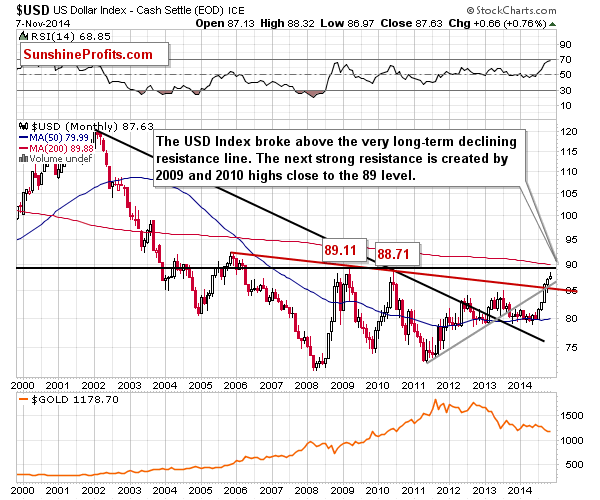
On Friday we wrote the following:
The USD Index is after a major breakout and there is no strong resistance level until about 89. This means that the USD Index is likely to rally for another 1 – 1.5 before the top is in. In other words, the USD Index has room for further gains and gold seems to have room for further declines.
The above hasn’t changed even though the USD Index declined a bit on Friday. It didn’t reach an important resistance level before Friday’s decline and the move above the previous 2014 high is confirmed. Consequently, it’s likely that the rally will continue until the USD Index reaches at least the 2010 high, and more likely the 2009 high.
This gives us significant room for a further rally – and a further decline in gold.
On Friday, however, gold moved higher on strong volume, which is a bullish sign. Gold didn’t manage to close the week above the 2013 low, so the breakdown below it was not invalidated – which in turn is a bearish sign. Moreover, gold corrected to the 38.2% Fibonacci retracement, which means 2 things. Firstly, the current move is still down – until we see a move above the 61.8% retracement the rally will be a correction, not necessarily a beginning of a bigger upswing, and gold hasn’t even moved above the lower retracement of 38.2%. Secondly, the rally could be already over as the resistance was reached.
Overall, gold’s price/volume action that we saw on Friday was less bullish than it seemed to be. Still, the short-term situation is now more bullish than it was before Friday’s session.
In the case of the gold to USD Index ratio, we see that the breakdown below the 2013 low was definitely not invalidated, but we also see that gold hasn’t moved back to it (or any other significant resistance level), so it’s wouldn’t be surprising if Friday’s rally were to be followed by another move higher.
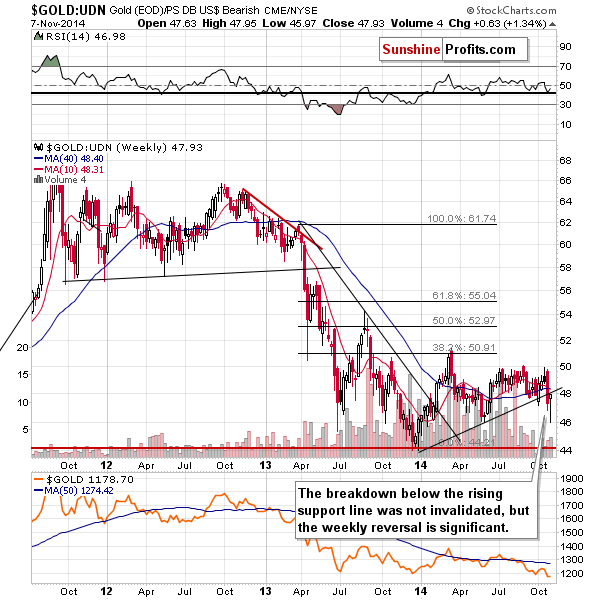
From the non-USD perspective, gold has moved back to the support level, but not above it. This makes a subsequent decline quite likely. On the other hand, the candlestick based on the last week price changes is a hammer, which signals a reversal. Overall, the short-term outlook is rather unclear based on the above chart.
Silver reversed as well, but overall ended the week more than 2% lower. The strong support levels and our target area were not reached and it doesn’t seem that the decline is over, but a pause is not out of the question, especially that the RSI indicator shows that silver is extremely oversold.
Speaking of the RSI, there was a situation in the past similar to the current one. In April 2013 silver corrected part of its previous decline when the RSI was similarly oversold. Please note that back then the white metal declined once again after a few weeks and silver didn’t rally significantly during the pause. It seems quite likely that we will see something similar also this time. However, the pause may not be that long as we are quite likely in the final part of the entire decline that started in 2011, and the final stages of a given move tend to be rather sharp – especially in the case of silver.
Gold stocks moved higher last week after reaching our initial target area but that’s no proof that the decline is completely over. During the 2008 decline there were sharp corrective upswings as well, but they didn’t mean that the decline was over. The current decline has been significant, so a corrective upswing (a pause within the decline) would be something normal.
How high could gold stocks go before the decline is resumed? It’s a tough call as the market has been very volatile lately, but at this time we wouldn’t rule out a move back to the previously broken support at the 2013 low. The 38.2% Fibonacci retracement based on the recent decline is very close to it, so it seems quite likely that the 185-190 level would stop a rally.
Before summarizing, let’s take a look at one additional chart that suggests that a corrective upswing is to be expected.
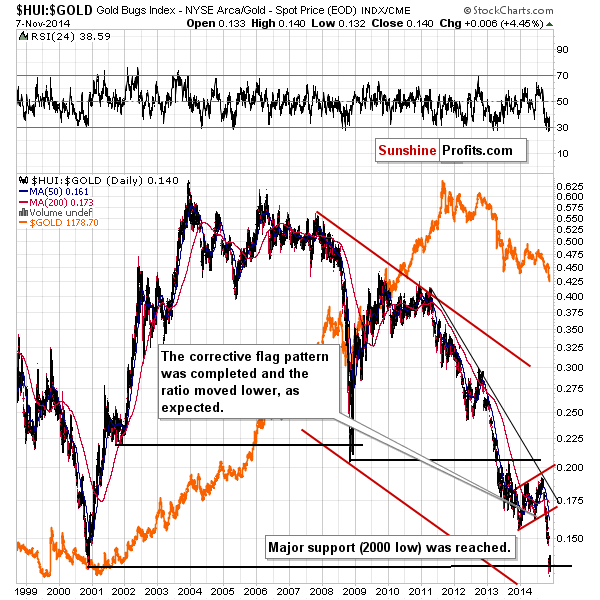
The gold stocks to gold ratio moved to its 2000 low, which is a major support level. This doesn’t necessarily mean that the final bottom is in, but it does make a corrective upswing more likely.
Our previous comments on the ratio remain up-to-date:
The gold stocks to gold ratio moved to a major support level – the 2000 low. In other words, if someone purchased gold stocks (on average) at the 2000 bottom in order to multiply gold’s gains and someone else just bought gold, they would both have the same amount of money at this time.
As you may recall, the HUI to gold ratio at its 2000 bottom is one of the things that we were expecting to see as the final bottom confirmation. However, at this time there are not enough additional signs to change the overall outlook (based on the silver to gold ratio, for example, we are likely to see further declines).
Can the above chart not mean that the final bottom is in? Yes. There were generally 2 cases, when the ratio dropped sharply and approached important (not as important as this one, but still), long-term support levels: in 2008 and in early 2013. In both cases the previous lows didn’t stop the decline. In 2008 there was a small move below the support level before gold stocks rallied again and in early 2013 there was only a corrective upswing to the 2008 low that verified the breakdown – declines followed.
Summing up, the final bottom is most likely not yet in, but there are some signs that point to further increases in the very short term (several days). Not all signs, however, suggest strength in the short run – there are some that suggest further declines (gold below the 2013 low and non-USD gold below the rising support/resistance line). The situation was not as clear on Friday, as it is now, as we now have the final weekly price changes and weekly closing prices. All in all, the outlook for the next few weeks remains unchanged and bearish (we are likely to see lower gold, silver and mining stock values), but the outlook for the next week or so is a bit unclear. Consequently, it seems that waiting on the sidelines for either a bearish or bullish confirmation is a good idea now. In other words, we think that taking profits off the table is a good idea at this time. The odds favor a move lower, but the risk associated with keeping a short position at this time seems too high.
We opened short positions on Oct. 27 (based on the previous trading day’s closing prices of $1,231.20 in gold, $17.18 in silver, and 184.39 in the HUI Index) and we doubled them on Oct. 30. The profits on this 2-week long short position are sizeable, especially in the case of silver (the white metal declined more than $1.50). Of course, it would be even better to get out at the exact bottom, but that’s simply not something that can be done each and every time (we had exited the previous long position based on the Oct. 21 closing prices, which was the top, though).
As always, we will continue to monitor the situation and report to our subscribers accordingly. We will quite likely open another trading position shortly – stay tuned.
To summarize:
Trading capital (our opinion): No positions
Long-term capital (our opinion): No positions
Insurance capital (our opinion): Full position
You will find details on our thoughts on gold portfolio structuring in the Key Insights section on our website.
As always, we’ll keep our subscribers updated should our views on the market change. We will continue to send them our Gold & Silver Trading Alerts on each trading day and we will send additional ones whenever appropriate. If you’d like to receive them, please subscribe today.
We were bullish on gold as far medium-term is concerned for the vast majority of the time until April 2013. After that we have generally been expecting lower prices. Are we gold bears? No – we view this decline as lengthy, but temporary. We expect gold to rally in the coming years, but instead of following the buy-and-hold approach, we exit the long-term precious investments at the most unfavorable times and re-enter when things look good again, thus saving a lot of money. Additionally, our Gold & Silver Trading Alerts help you profit from the short-term price swings. We invite you to examine our premium services and encourage you to sign up for our free mailing list today.
Thank you.


-
I know Mike is a very solid investor and respect his opinions very much. So if he says pay attention to this or that - I will.
~ Dale G.
-
I've started managing my own investments so view Michael's site as a one-stop shop from which to get information and perspectives.
~ Dave E.
-
Michael offers easy reading, honest, common sense information that anyone can use in a practical manner.
~ der_al.
-
A sane voice in a scrambled investment world.
~ Ed R.
Inside Edge Pro Contributors

Greg Weldon

Josef Schachter

Tyler Bollhorn

Ryan Irvine

Paul Beattie

Martin Straith

Patrick Ceresna

Mark Leibovit

James Thorne

Victor Adair

